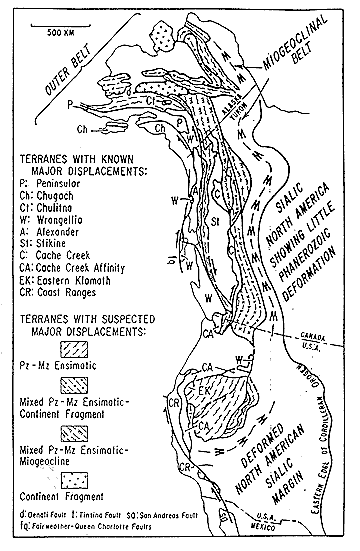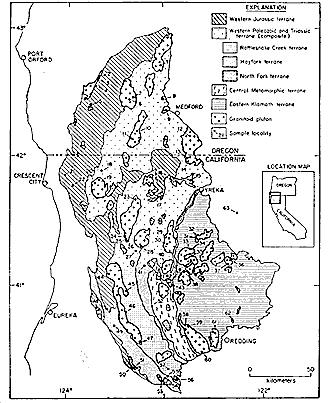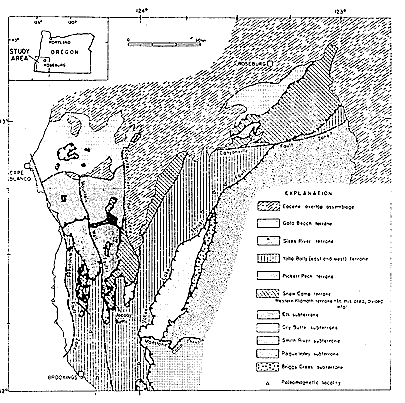
The title of one of the presented papers - "Terranes as Terrains" - aptly summarizes the essence of the study. Freely translated, this refers to an attempt to determine whether certain kinds of geo-structural units (terranes) have distinctive and diagnostic landscape features (terrains) that facilitate their identification and add to understanding their origin, significance, and history. Three goals prompted this investigation:
The word "terrane" originally referred to "a crustal block, usually bounded by faults, with a geologic history distinct from histories of juxtaposed blocks of differing characteristics". With the advent and acceptance of plate tectonic theory, this concept was modified by new insights into certain crustal blocks that came to be called "tectonostratigraphic", "accreted", or "suspect" terranes. In this view, terranes are considered to be diverse segments of crust that originated and developed often far from their present locations and over time were transported on a moving plate that converged against another plate, eventually colliding with a continental margin (along or within this second plate). There, they were obducted (shoved onto) against the margin rather than incompletely subducting (diving under) the second plate, thereby becoming accreted to that plate. To give an example: masses such as microcontinents embedded in oceanic crust enroute to a subduction zone will be unable to follow that crust downward and will be "scraped off" along thrust faults to emplace along the growing edge of the continental crust on the other plate. Or, a variant: if an island arc complex (e.g., Java, p. 17-2) on the upper plate above a subduction zone were squeezed between two converging plates as a continent on the lower plate eventually reached the zone, much of the arc would be caught "in the crunch" to be driven on and welded to (accreted) the encroaching continent. The usual criteria for terrane recognition are centered on stratigraphic, structural, and paleomagnetic discontinuities between adjacent terranes. (For a quick review of relevant concepts, read pp. 507ff and other parts of Chapter 18 in the introductory text: Physical Geology by B.J. Skinner and S.C. Porter, 1994, J. Wiley & Sons, Inc.)
Whereas in the thinking about growth of continents prior to the accreted terrane concepts, complex geo-crustal units
in the continents were largely explained as consequences of fold-squeezing
and fault transport during mountain building at geosynclinal sites,
without much geographic displacement. Now, the new view recognizes
distant site origins and relocations owing to long movements on
the "conveyor belts" of diverging plates. Continents themselves
thus grow by progressive accretion of numerous plates over time
onto early cratonic nuclei. Since this concept first gained favor
in the 1970s, hundreds of terranes have now be recognized on all
continents, in the sense that older ideas about mapped geologic
units have been re-interpreted to fit the terrane model. As an
illustration of the terrane addition/continental growth version,
consider this map that portrays a collage of the major terranes
emplaced along the western margin of North America.

The Klamath Mountains of northwestern California-Southwestern
Oregon were the type locality for development of the concept of
accreted terranes, owing to pioneering mapping and interpretation
by Irwin, Blake, and others. Early, somewhat generalized, maps
of the two adjacent areas display the first interpretations of these assemblages of terranes (the upper map that follows shows the terranes in northern California and part of the Oregon Klamaths; the lower map continues coverage in Oregon to the north and west) :


Each of the named terranes is considered a unit which, after travelling some distance, "docked" against the paleo-North American continent over some specific period. Most of the inner (continentward) units are progressively older than those outside, although thrust faulting can sometimes carry a younger unit over part of older ones. Each terrane maintains some internal structural integrity and consists of series of stratigraphic units (formations), many not having counterparts in other nearby terranes (those that do were likely deposited across boundaries after terrane emplacements).
Code 935, Goddard Space Flight Center, NASA
Written by: Nicholas M. Short, Sr. email: nmshort@epix.net
and
Jon Robinson email: Jon.W.Robinson.1@gsfc.nasa.gov
Webmaster: Bill Dickinson Jr. email: rstwebmaster@gsti.com
Web Production: Christiane Robinson, Terri Ho and Nannette Fekete
Updated: 1999.03.15.